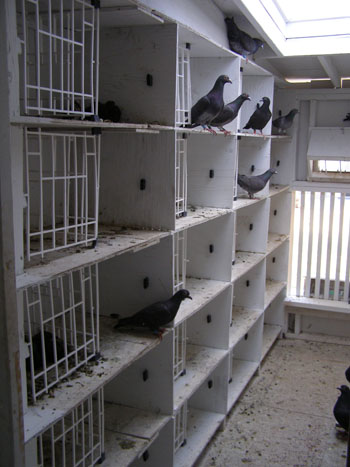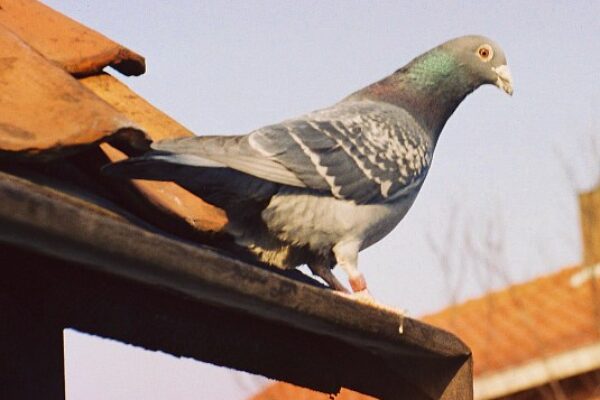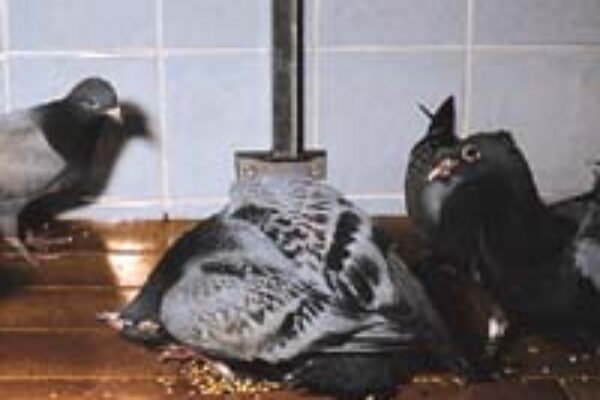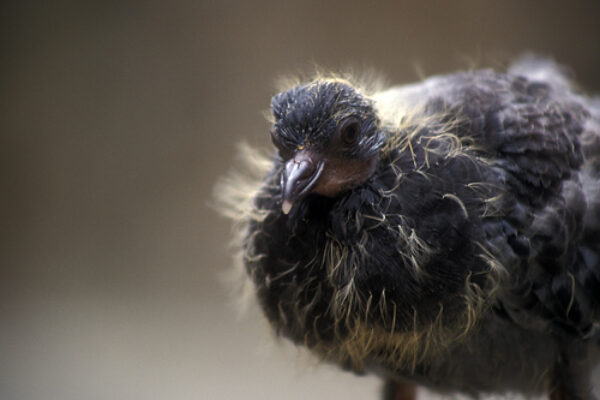Double Widowhood Part 3
 The last point I discussed was just prior to training the old birds for racing. It is imperative that the young birds be weaned as soon as possible. Only then will we see the dramatic boost in health that we are looking for. I will have all of my young birds out of the loft three weeks prior to the first race. The old birds will have been exercising for at least three to four weeks before I actually begin to train them. For me this training for the first Old Bird race takes place at a minimum of three weeks prior to the first race. Normally, I will take just the Cock birds because the hens have either just been separated or are ready to be separated that week. My practice is to go only about 16 or 20 miles on a very nice day. At this time of the year you certainly do not want to hurt the pigeons by over extending their muscles. Also, if the weather is too cold I will consider taking them out later or wait until the next day. This caution comes from experience. I well remember jumping the gun one year due to my excitement at playing widowhood and getting the widowers out for a club toss on a rather dubious day. The weather turned for the worse, I felt that the trucker being an experienced pigeon flyer would bring them back. Needless to say, the day turned out disastrous and even my earliest arrivals were cold and wet. All form was lost in the loft and it took a long time before it started to return. Armed with this vivid memory of twenty years ago, I now proceed slowly and carefully with a little more thought to the oncoming race season.
The last point I discussed was just prior to training the old birds for racing. It is imperative that the young birds be weaned as soon as possible. Only then will we see the dramatic boost in health that we are looking for. I will have all of my young birds out of the loft three weeks prior to the first race. The old birds will have been exercising for at least three to four weeks before I actually begin to train them. For me this training for the first Old Bird race takes place at a minimum of three weeks prior to the first race. Normally, I will take just the Cock birds because the hens have either just been separated or are ready to be separated that week. My practice is to go only about 16 or 20 miles on a very nice day. At this time of the year you certainly do not want to hurt the pigeons by over extending their muscles. Also, if the weather is too cold I will consider taking them out later or wait until the next day. This caution comes from experience. I well remember jumping the gun one year due to my excitement at playing widowhood and getting the widowers out for a club toss on a rather dubious day. The weather turned for the worse, I felt that the trucker being an experienced pigeon flyer would bring them back. Needless to say, the day turned out disastrous and even my earliest arrivals were cold and wet. All form was lost in the loft and it took a long time before it started to return. Armed with this vivid memory of twenty years ago, I now proceed slowly and carefully with a little more thought to the oncoming race season.
After the separated hens have been on their own for a week to recuperate, I will include them on all tosses. Each time they return, they are allowed to go back to their nest and then I carefully return them to their own section. In the three week training period, I will try to toss both sexes at least thirteen to fifteen times. The emphasis is not on distance, but rather repetitions. Most of the tosses will be from 30 to 40 miles with only a few further than this. Of course I will continue with the exercise around the loft and adjust the training according to my observations. For instance, if the flying exercise time around the loft drops off dramatically then I will discontinue training and exercising until I find out what is wrong. Sometimes it’s just a couple of days rest that they need and they are back to their normal exercise time. They should be constantly moving in the sky, darting here and there, landing momentarily and then off again. Thirty minutes at this time of the year is more than enough. I try to keep the birds to a routine so as not to upset their internal clock. Therefore, if I toss in the morning, then I will exercise them at their normal time in the evening.
Since I do not have a partner, training is a little more difficult. After crating both the hens and cocks in separate baskets, I then make sure that the only trap open is where the nest boxes are kept. On occasions I will allow the hens into this section first by letting them go a shorter distance. I don’t feel that it is critical. If I am fortunate enough to be at home when they arrive, then I will allow them in the open doors. It is a sight to see them pitch from the air and swish into their box. Over the last 20 years that I have flown widowhood, I have seldom been home when they arrived, but I can assure you that it has not adversely affected my results. Usually, by the time I return home the cocks and hens are in their respective nest boxes and are crouched over the bowl. At this time, I carefully remove the hen to her own section which is right next door . There is a solid partition between the sections and the hens loft is fitted with perches only while on the cock side there are only nest boxes. Once the hen is removed I turn the bowl over and close off the half section which contains the bowl. I like the birds to calm down and rest for it is the resting phase which is one of the most important factors in racing double widowhood. Some fanciers spoil this particular time by returning to the loft too many times or keeping the hens beside the cocks without a slid partition or allowing the sexes together too often for too long. Try at all costs to avoid these situations. If it is a particularly nice day then set a warm bath inside for both of the sexes as this tends to help calm them down and rest. After the birds have been trained for their targeted thirteen or fifteen tosses then they should be race ready.
Our fist race is about 130 miles which is anywhere from a two and a half hour flight to three hours. If your first race is longer, then I would definitely increase the number of tosses because you want to make sure that they handle the time on the wing without hurting themselves for the rest of the year.
We will all readily agree that medicating is often a double edged sword. How much are you giving up in the way of natural resistance and good healthy bacteria in order to achieve the desired effect on unwanted bacteria? Over the years I have had the opportunity to experiment using different amounts of medication varying from using nothing to a fixed weekly programme. From experience my worst year ever was when I decided to treat the birds very naturally. ( homeopathically). Likewise the other extreme does not work either and those lofts who are heavy medicators soon succumb to the stress of over medicating. Where does this leave us?- in the middle. ” All things in moderation.”
During the first week of training, I generally treat against trichomoniasis for five days with either Emtryl or Ridzol. Make sure that they receive the right amount – one teaspoon per gallon for the entire five day period. Thanks to the training of Dr.G. Chalmers, I am now able to check faecal samples for either worms or coccidiosis. Neither have been a problem in the past as I watch very carefully for any changes in the loft. If the droppings on your birds were off then I would strongly suggest seeking a reputable Pigeon vet to give you advice.
If the widowers are exercising freely and are training well then this is the extent of the medication I administer before the first race. However, if the birds are not willingly exercising prior to the first race then you have problems. A sure sign of a respiratory problem is if during training, as soon as the birds are released, they circle and circle and circle. Also, if you are lucky enough to be present as the trainers are landing then observe very closely and look for the following tell tale signs. Upon arrival do they open their beaks wide.. almost as if they are yawning? Do they rub their nostrils ( beak ) on their wings? If the weather is cool, do they land with their beaks open and panting? If you answered yes to any of these then you may certainly have a respiratory problem. What should you do? For the next ten days I would rest the birds and place them on a medication programme consisting of an anti-tricho drug, Emtryl or Flagyl or Ridzol etc. plus an anti-respiratory drug combination( Tylosin and Doxycycline). Make sure you use an anti-tricho drug that you have not used yet this year. Trichomoniasis is an opportunistic bacteria and quite often waits for a little stress on the birds and then it opens the door for a secondary infection such as respiratory.
Once we start racing we will discuss which medications to use and how. Hopefully, your birds will really look the part and be ready for the competitions ahead. If you have been conscientious with the training, cleaning, keeping smaller numbers and observing the birds daily they should look good.
Handling of the Widowhood Hens
As has been mentioned earlier I like to separate the hens when the young birds are about eighteen to twenty days old. If the hens happen to lay before this let them sit for two to three days then remove the eggs, bowl and the hen. You do not want these birds to start moulting. Our 11 week season is short enough when you consider the length of time that you keep them so make sure they compete with as full a wing as possible.
The widowhood hen section should contain only perches and preferably some kind of mechanism (like a screen door) to enclose the hens once they are on the perches. Why? As I see it the only problem with racing widow hens, is that they love to mate to each other. After four, five or six weeks ( sometimes sooner ) the hens will start to mate. I have heard of or seen many, many, different methods that have been put into practice to stop this. For me, the one that works is to close them in once they are on their perches. My perches are about 12 x 12 and I have a 2 x 1 screened frame which closes over the perches and keeps each bird in its own separate perch. In the morning when my time is very limited, the hens will not be exercised, but they will be let out on the floor for a light, cereal feed ( barley, rice, wheat and white milo ) a drink and then back up onto their perches. At this time I will close the screen door over the birds. Next, I hang a dark curtain over this 2 x 1 frame so that the hens can not see out. Now I can give my widowhood cocks their exercise and I do not have to worry about the sexes seeing each other. The widowers are generally out for about 30 minutes in the beginning of the year. Be careful if the weather is not conducive to good form then keep them in. Some widowhood fliers allow their cocks only out once a day and they compete very well. This exercise could also take place in the afternoon, it really does not matter. Once the widowers are back in the loft then take the curtain away from the hens side. Now, try and leave both sexes alone for the next eight hours. This is the time of the day when I feel that the widowers get an edge on their competition by merely resting and sunning….absolute bliss.
I had hoped to discuss feeding, but I will incorporate that into the next article. I leave you with this thought…Some people try to find ways to eliminate their competition….Why not try eliminating one factor in your own loft that might be keeping you from beating the competition– numbers!! By reducing your numbers the health, form and race results of your loft will improve considerably.
- Double Widowhood Part 1
- Double Widowhood Part 2
- Double Widowhood Part 3 <= You Are Here
- Double Widowhood Part 4
Double Widowhood Part 3 by John Marles
The Leading Online Pigeon Racing and Racing Pigeons Magazine – The Pigeon Insider









lla pague para recivir los articulos pero perdi mi contra sena y no se como agarrar todo de nuevo y cada vez que trato de volver a inscrivirme me dise que lla estoy inscrito que puedo hacer?